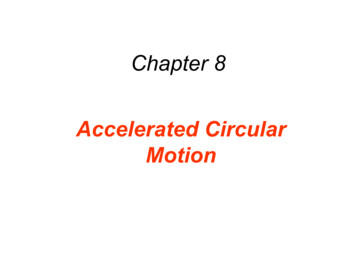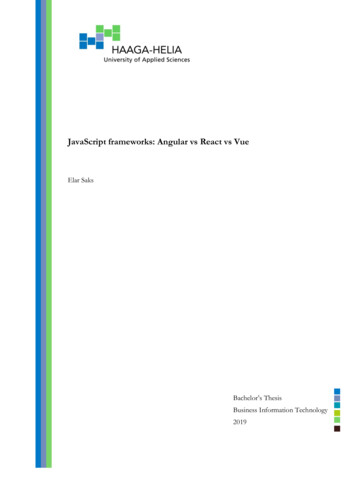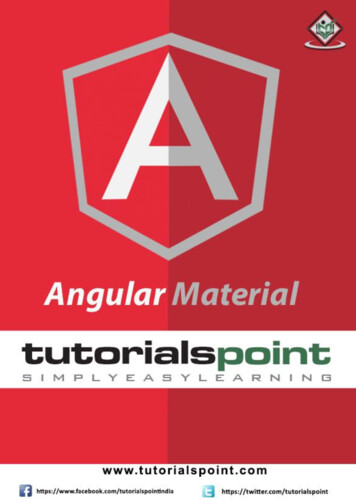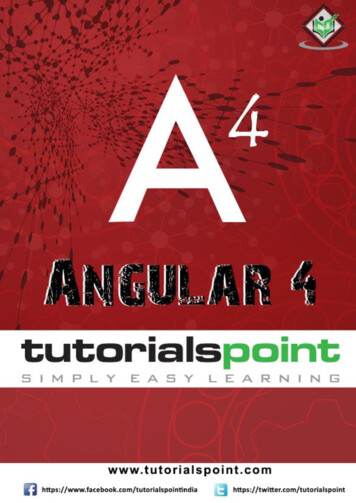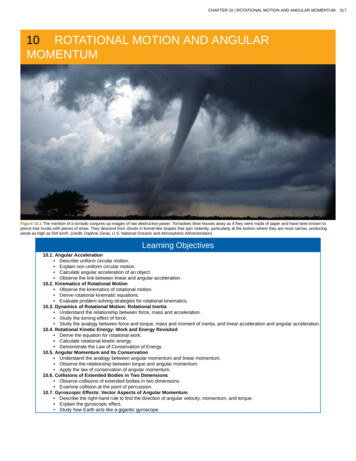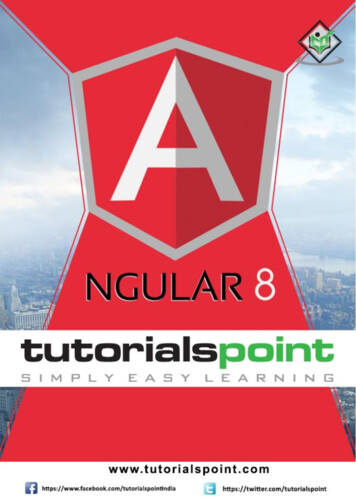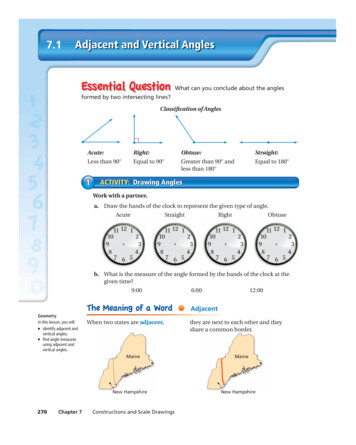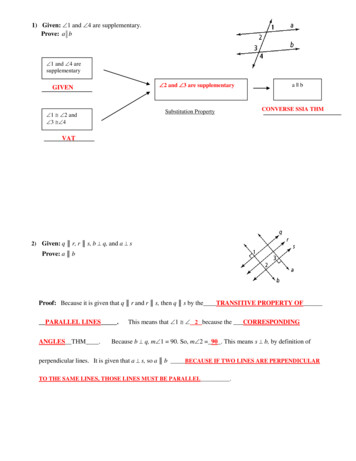
Transcription
Chapter 7Rotational MotionAngles, Angular Velocity andAngular AccelerationUniversal Law of GravitationKepler’s Laws
Angular Displacement 1.2.3.Circular motion about AXISThree different measures ofangles:DegreesRevolutions (1 rev. 360 deg.)Radians (2π rad.s 360 deg.)
Angular Displacement, cont. Changeindistance of a point:s 2πr N (N counts revolutions) rθ (θ is in radians)
ExampleAn automobile wheel has a radius of 42 cm. If a car drives10 km, through what angle has the wheel rotated?a) In revolutionsb) In radiansc) In degrees
SolutionNote distance car moves distance outside of wheel movesa) Find N:Basic formulas 2πrN rθKnown: s 10 000 m, r 0.42 mN s2πr 3 789b) Find θ in radiansKnown: Nθ 2π (radians/revolution) Nc) Find θ in degreesKnown: Nθ 2.38 x 104 rad.θ 360 (degrees/revolution) Nθ 1.36 x 106 deg
Angular Speed Can be given in Revolutions/sRadians/s -- Called ωDegrees/sω θ f θitin radiansLinear Speed at rv 2π r θ f θi (in revolutions)t2π r θ f θi (in degrees) t3602π r θ f θi (in radians) ωrt2π
ExampleA race car engine can turn at a maximum rate of 12 000 rpm.(revolutions per minute).a) What is the angular velocity in radians per second.b) If helipcopter blades were attached to the crankshaft while itturns with this angular velocity, what is the maximum radius ofa blade such that the speed of the blade tips stays below thespeed of sound.DATA: The speed of sound is 343 m/s
Solutiona) Convert rpm to radians per second rev. 12 000 min 2π rad 1256 radians/s rev sec 60 min b) Known: v 343 m/s, ω 1256 rad./sFind rBasic formulav ωrr vω .27 m
Angular Acceleration Denotedα by αω f ωitmust be in radians per sec. Units of angular acceleration are rad/s² Every portion of the object has sameangular speed and same angularacceleration ω
Analogies Between Linear andRotational MotionRotational Motion(ω θ i ω f )2tLinear Motion(v v ) x tif21 2 θ ω i t αt21 2 x v i t at2ω ωi αtv v i atω ω 2α θv 2 v i2 2a x22i
Linear movement of a rotating point Distance Speed Accelerations θrv ωr Different points onthe same object havedifferent linearmotions!a αrOnly works when θ, ω and α are in radians!
ExampleA pottery wheel is accelerated uniformly from rest to a rateof 10 rpm in 30 seconds.a.) What was the angular acceleration? (in rad/s2)b.)How many revolutions did the wheel undergo duringthat time?
SolutionFirst, find the final angular velocity in radians/s.1 rad rad rev. ω f 10 2π 1.047 sec rev min 60(sec/ min )a) Find angular accelerationBasic formulaα ω f ω i αtω f ωit 0.0349 rad./s2b) Find number of revolutions: Known ωi 0, ωf 1.047, and t 30First find θ in radiansBasic formula θ ωi ω f2 θ tωft 15.7 rad.2 θ (rad.)N 2.5 rev.2π (rad./rev.)
Solutionb) Find number of revolutions:Known ωi 0, ωf 1.047, and t 30,First find θ in radiansBasic formula θ ωi ω f2t θ ωft 15.7 rad.2 θ (rad.) 2.5 rev.N 2π (rad./rev.)
ExampleA coin of radius 1.5 cm is initially rolling with a rotationalspeed of 3.0 radians per second, and comes to a restafter experiencing a slowing down of α 0.05 rad/s2.a.) Over what angle (in radians) did the coin rotate?b.) What linear distance did the coin move?
Solutiona) Find θ, Given ωi 3.0 rad/s, ωf 0, α -0.05 rad/s2Basic formula22fiω ω 2α θω i2 θ 2α 90 radians 90/2π revolutionsb) Find s, the distance the coin rolledGiven: r 1.5 cm and θ 90 radBasic formulas r θs r θ , ( θ is in rad.s) 135 cm
Centripetal Accelerationin circle at constant SPEED doesnot mean constant VELOCITY Centripetal acceleration results fromCHANGING DIRECTION of the velocity Moving
Centripetal Acceleration, cont. Acceleration isdirected toward thecenter of the circleof motionBasic formularr va t
Derivation: a ω2r v2/rFrom the geometry of the Figure v 2v sin( θ / 2) v θ for small θFrom the definition of angular velocity θ ωt v vωt2 vv2 vω ω r a tr
Forces Causing CentripetalAcceleration Newton’sSecond LawrrF ma Radialacceleration requires radial force Examples of forcesSpinning ball on a string Gravity Electric forces, e.g. atoms
ExampleA space-station is constructed like a barbell with two1000-kg compartments separated by 50 meters thatspin in a circle (r 25 m). The compartments spinsonce every 10 seconds.a) What is the acceleration at the extreme end of thecompartment? Give answer in terms of “g”s.b) If the two compartments are held together by acable, what is the tension in the cable?
Solutiona) Find acceleration aGiven: T 10 s, r 25 mBasic formula rad rev ω 2π N rev s Basic formula2v2a ω rrFirst, find ω in rad/sω 2π 0.1Then, find accelerationa ω 2 r 9.87 m/s2 1.006 g
Solutionb) Find the tensionGiven m 1000 kg, a 1.006 gBasic formulaF maT ma 9870 N
ExampleA race car speeds around a circular track.a) If the coefficient of friction with the tires is 1.1, whatis the maximum centripetal acceleration (in “g”s) thatthe race car can experience?b) What is the minimum circumference of the track thatwould permit the race car to travel at 300 km/hr?
Solutiona) Find the maximum centripetal accelerationKnown: µ 1.1Remember, only consider forces towards centerBasic formulaf µnF maf µmgma µmga µgMaximum a 1.1 g
Solutionb) Find the minumum circumferenceKnown: v 300 km/hr 83.33 m/s, a 1.1 gFirst, find radiusBasic formula2v2a ω rrv2r aThen, find circumferenceL 2πr 4 043 mIn the real world: tracks are banked
ExampleAAyo-yo is spun in a circle as shown.If the length of the string is L 35cm and the circular path isrepeated 1.5 times per second, atwhat angle θ (with respect to thevertical) does the string bend?
SolutionBasic formularrF maApply F ma for boththe horizontal andvertical components.ma y 0 Fy T cosθ mgT cosθ mgBasic formula2a ω rma x mω 2 r mω 2 L sin θ F2 x T sin θmω L Tr Lsinθ
SolutionWe want to find θ, given ω 2π·1.5 & L 0.35ma x mω r mω L sin θ F2 x T sin θmω L T22ma y 0 Fy T cosθ mgT cosθ mg2 eq.s & 2 unknowns (T and θ)mggcosθ 2Tω Lθ 71 degrees
Accelerating Reference FramesConsider a frame that is accelerating with afF maF ma f m(a a f )Fictitious forceLooks like “gravitational” forceIf frame acceleration g,fictitious force cancels real gravity.Examples: Falling elevator, planetary orbitrotating space stations
DEMO: FLYING POKER CHIPS
ExampleWhich of these astronauts experiences “zero gravity”?a)b)c)d)An astronaut billions of light years from any planet.An astronaut falling freely in a broken elevator.An astronaut orbiting the Earth in a low orbit.An astronaut far from any significant stellar object in arapidly rotating space station
Newton’s Law of UniversalGravitation Forceis always attractive Force is proportional to both masses Force is inversely proportional toseparation squaredm1m2F G 2r3 m 11 G 6.67 10 2 kg s
Gravitation Constant Determined experimentallyHenry Cavendish, 1798Light beam / mirroramplify motion
ExampleGiven: In SI units, G 6.67x10-11,g 9.81 and the radius of Earth is6.38 x106.Find Earth’s mass:Basic formulaMmF G 2r mgMmmg G 2RgRM G2 5.99x1024 kg
ExampleGiven: The mass of Jupiter is 1.73x1027 kgand Period of Io’s orbit is 17 daysFind: Radius of Io’s orbit
SolutionGiven: T 17·24·3600 1.47x106, M 1.73x1027, G 6.67x10-11Find: rFirst, find ω from the periodBasic formulaNω 2πt1ω 2π 4.28 10 6 sTNext, solve for rBasic formulaF ma mω r2Basic formulaMmF G 2rMω r G 2r GM 3r 2 ω 2r 1.84x109 m
Tycho Brahe (1546-1601) Lostpart of nose in a duel EXTREMELY ACCURATE astronomicalobservations, nearly 10X improvement,corrected for atmosphere Believed in Retrograde Motion Hired Kepler to work as mathematician
Johannes Kepler (1571-1630) First to: Explain planetary motionInvestigate the formation of pictures with a pin holecamera;Explain the process of vision by refraction within the eyeFormulate eyeglass designed for nearsightedness andfarsightedness;Explain the use of both eyes for depth perception.First to describe: real, virtual, upright and invertedimages and magnification
Johannes Kepler (1571-1630) First to: explain the principles of how a telescope worksdiscover and describe total internal reflection.explain that tides are caused by the Moon.He tried to use stellar parallax caused by the Earth'sorbit to measure the distance to the stars; the sameprinciple as depth perception. Today this branch ofresearch is called astrometry.suggest that the Sun rotates about its axisderive the birth year of Christ, that is now universallyaccepted.derive logarithms purely based on mathematics,
Isaac Newton (1642-1727) Invented CalculusFormulated the universal law of gravitationShowed how Kepler’s laws could be derived from aninverse-square-law forceInvented Wave MechanicsNumerous advances to mathematics and geometry
Kepler’s LawsAll planets move in elliptical orbitswith the Sun at one of the focalpoints.2. A line drawn from the Sun to anyplanet sweeps out equal areas inequal time intervals.3. The square of the orbital period ofany planet is proportional to cube ofthe average distance from the Sunto the planet.1.
Kepler’s First Law All planets move inelliptical orbitswith the Sun at onefocus. Any object boundto another by aninverse square lawwill move in anelliptical pathSecond focus isempty
Kepler’s Second Law A line drawn from theSun to any planet willsweep out equal areasin equal times Area from A to B and Cto D are the sameThis is true for any central force due toangular momentum conservation (next chapter)
Kepler’s Third Law Thesquare of the orbital period of anyplanet is proportional to cube of theaverage distance from the Sun to theplanet.2T K sun3r Fororbit around the Sun, KS 2.97x10-19s2/m3 K is independent of the mass of the planet
Derivation of Kepler’s Third LawBasic formulaMmF ma G 2r2a ω rBasic formula2πω TMmma G 2rMm2mω r G 2rGM 2r T24π 22T4π K sun3rGM3
ExampleData: Radius of Earth’s orbit 1.0 A.U.Period of Jupiter’s orbit 11.9 yearsPeriod of Earth’s orbit 1.0 yearsFind: Radius of Jupiter’s orbitBasic formula2T K sun3r2Earth3EarthTr3Jupiterr 2TJupiter3Jupiterr r3Earth2TJupiter2EarthT2/3rJupiter TJupiter 5.2 A.U. rEarth TEarth
Gravitational Potential Energy PE mgy is valid onlynear the Earth’ssurfaceFor arbitrary altitudeM EmPE Gr Zero reference level isinfinitely far from theearth
Graphing PE vs. positionM EmPE Gr
ExampleYou wish to hurl a projectile is hurled from thesurface of the Earth (Re 6.3x106 m) to analtitude of 20x106 m above the surface of theEarth. Ignore the rotation of the Earth and airresistance.a) What initial velocity is required?b) What velocity would be required in order forthe projectile to reach infinitely high? I.e., whatis the escape velocity?
SolutionGiven: R0 6.3x106, R 26.3x106, G, M 6.0x1024Find: v0First, get expression for change in PEBasic formulaMm PE GMm 1 1 r r PE G 0 rThen, apply energy conservationBasic formula1 2KE mv2 PE KE 1 1 1 2GMm mv0 r0 r 2Finally, solve for v0 6 600 m/s
Solution For Escape VelocityGiven: R0 6.3x106, R , G, M 6.0x1024Find: v0First, get expression for change in PEBasic formulaMmPE Gr1 PE GMmr0Then, apply energy conservationBasic formula1 2KE mv2 PE KE1 1 2GMm mv0r0 2Solve for v0 11 270 m/s
Angles, Angular Velocity and Angular Acceleration. Universal Law of Gravitation. Kepler's Laws. Angular Displacement Circular motion about AXIS Three different measures of angles: 1. Degrees. 2. Revolutions (1 rev. 360 deg.) 3. Radians (2πrad.s 360 deg.) Angular Displacement, cont.

